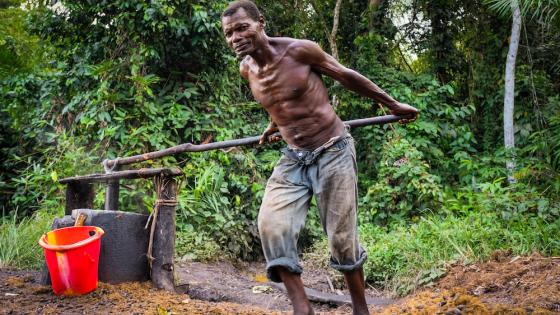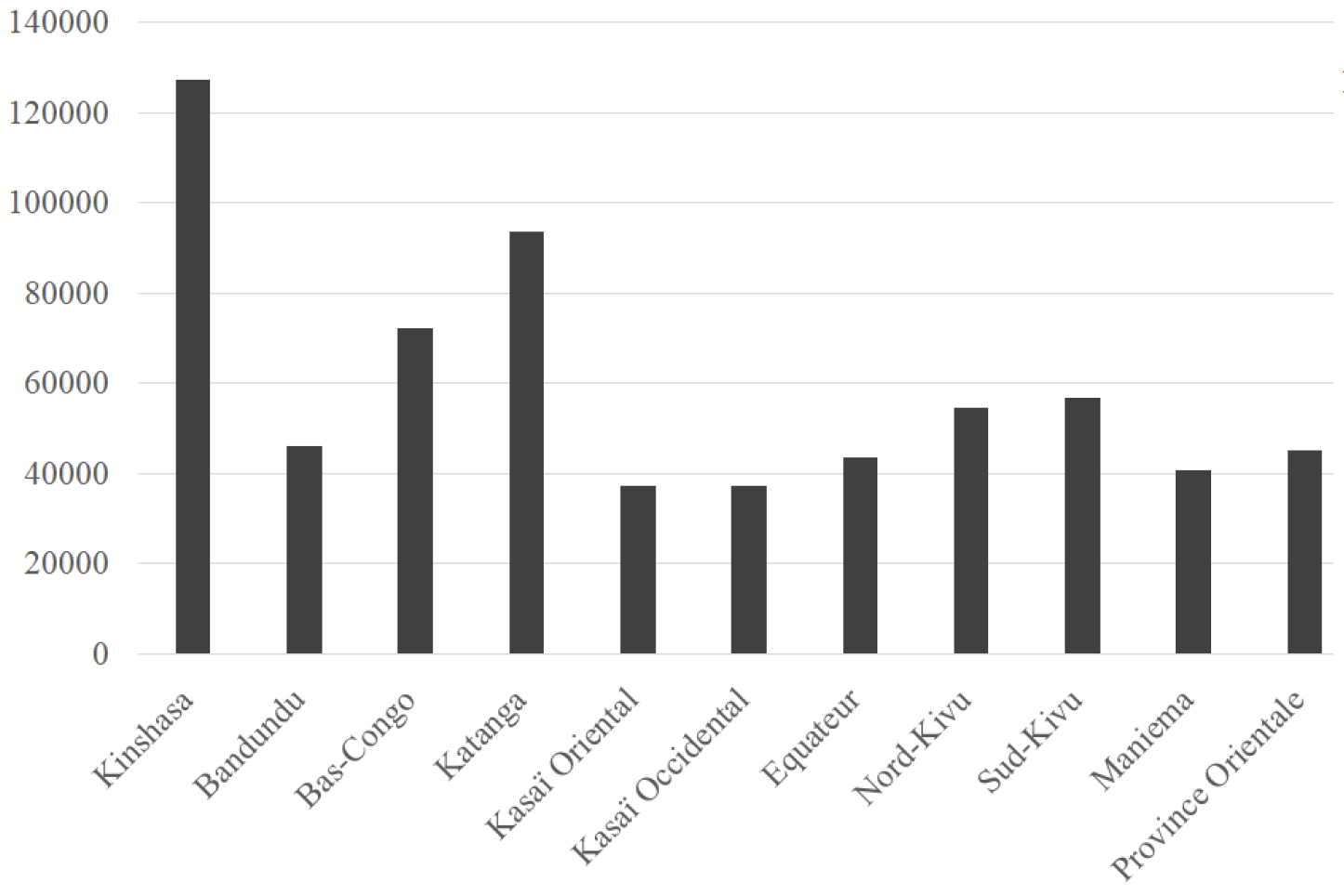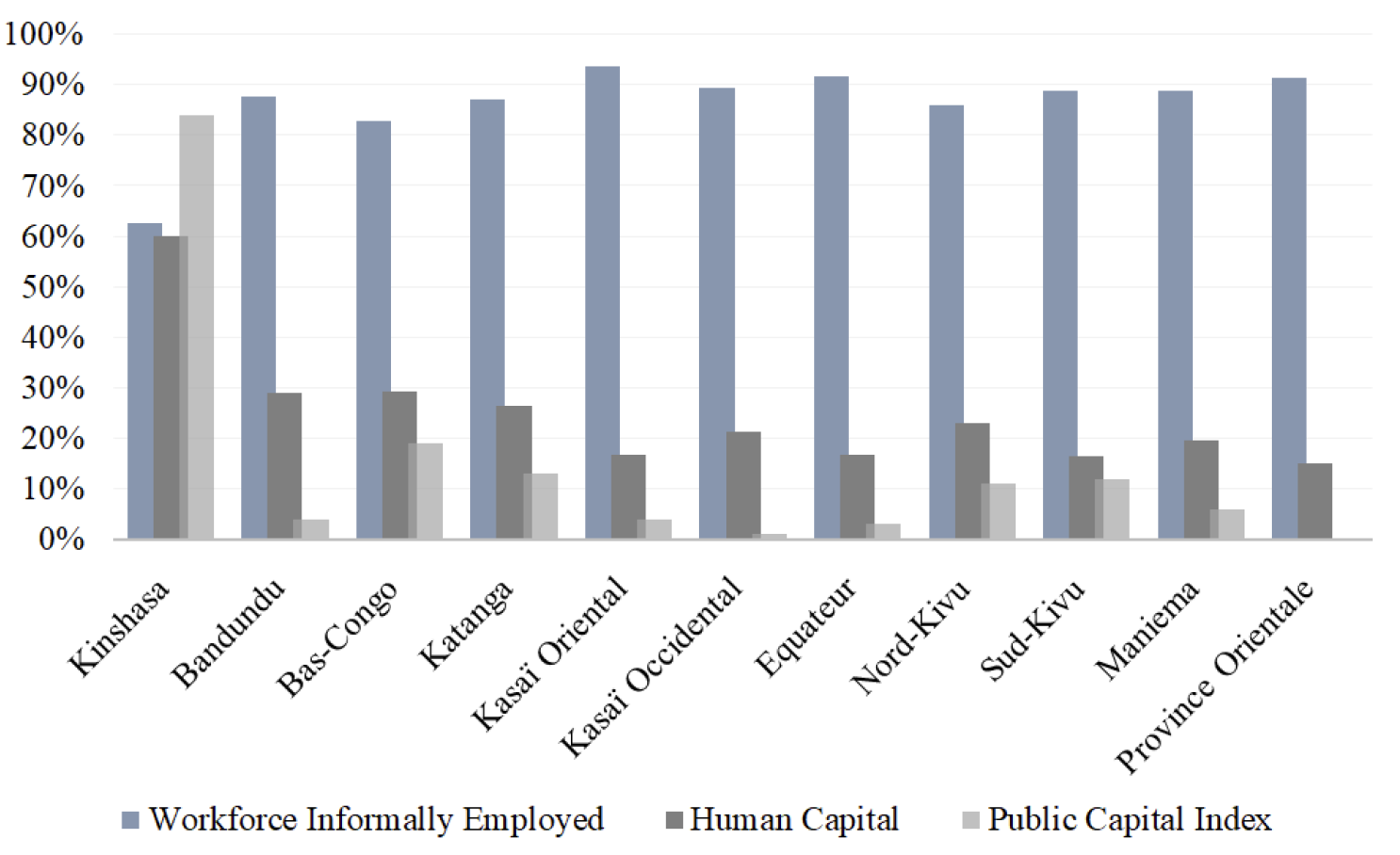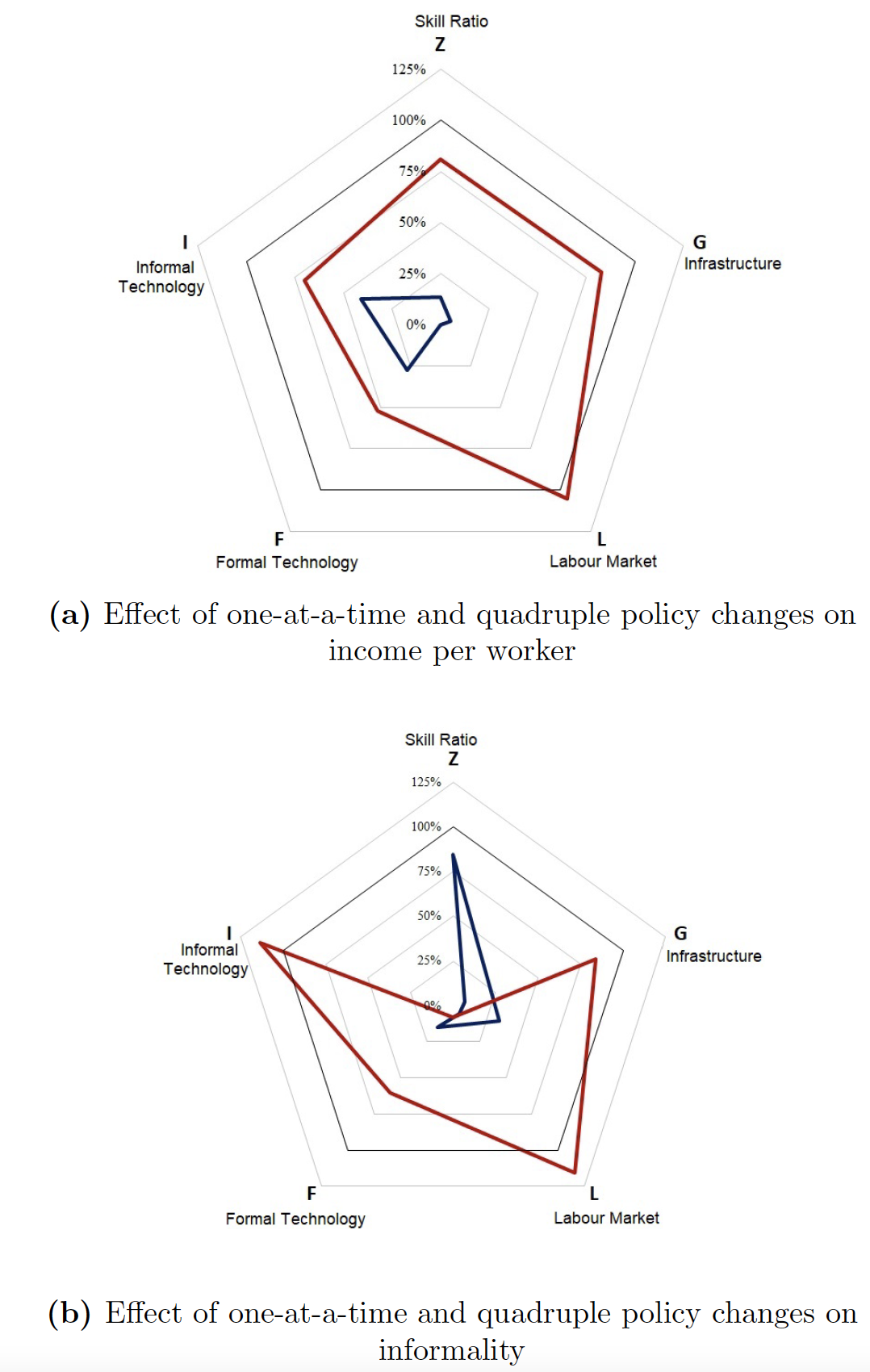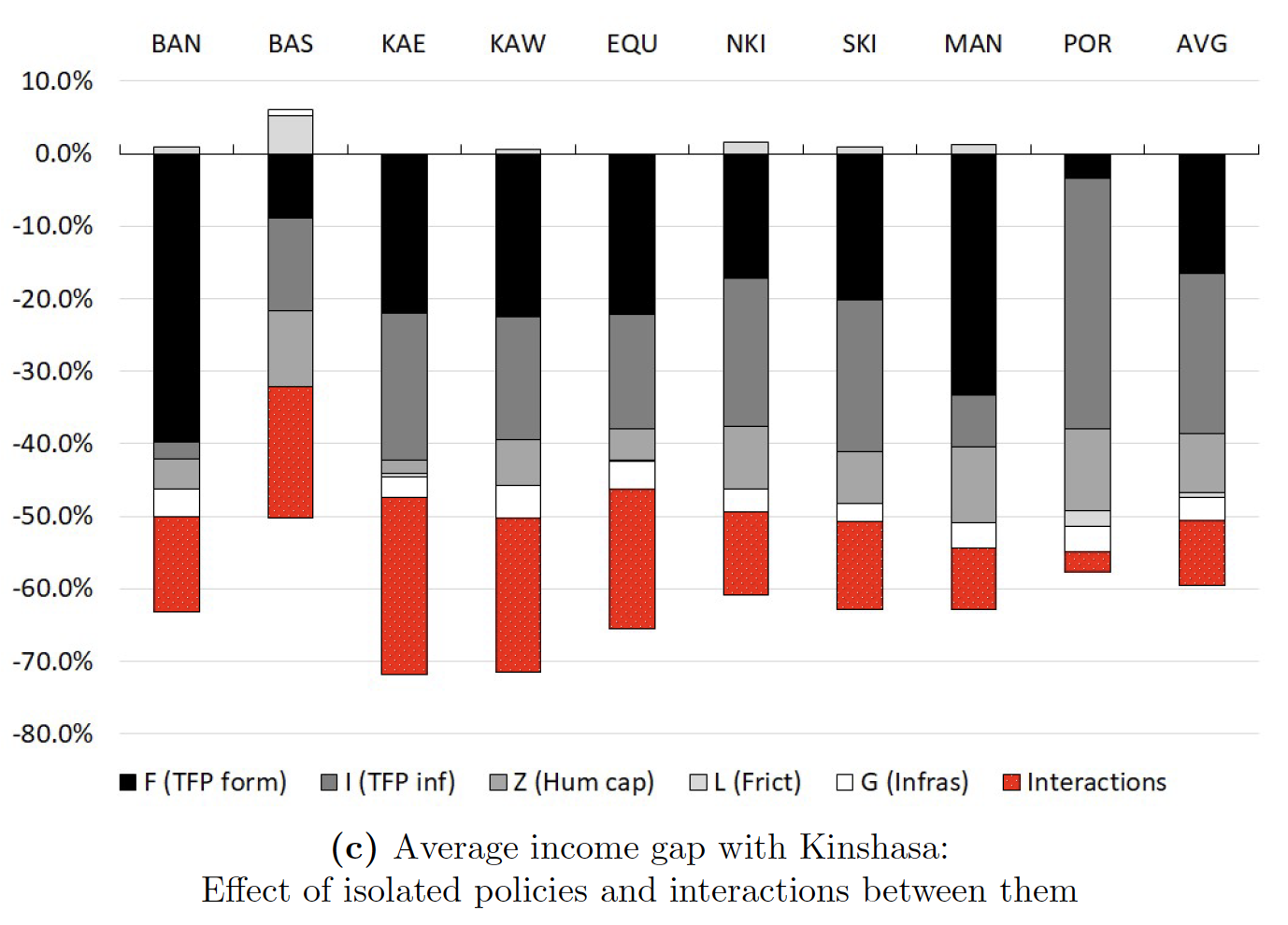For some time now, low economic growth performance as well as persistent poverty and spatial inequality on the African continent have attracted the attention of economists (Acemoglu et al. 2005, de la Escosura 2011, Gigineishvili et al. 2014). Too little attention has been paid, however, to the role of informality – the part of the economy that is neither governed nor monitored by any form of government – in governing the effectiveness of public policies (Dix-Carneiro et al. 2021). In recent work (Amuli Ibale et al. 2022), we focus on the Democratic Republic of the Congo (DRC) and develop a structural model to explain how mobility frictions between the formal and informal sectors can hamper the conduct of traditional development policies. We revisit the causes of inter (intra) regional inequalities and poverty and assess the relative effectiveness of policies targeting human capital, public infrastructure, labour market frictions and production technology in both formal and informal sectors.
Disparities across provinces and sectors in DRC
According to existing indicators, the DRC is one of the poorest, most unequal, and worst governed countries in the world. Disparities in economic performance across the provinces are illustrated in Figure 1. The bars in the top panel show 12 provinces in the year 2012, with taller bars representing provinces with greater levels of income per worker. The capital Kinshasa appears to be the richest province, while the poorest province is Kasai Oriental with a level of income per worker which is four times lower than that of Kinshasa. The bottom panel shows the distribution of public infrastructure (share of households with access to water, electricity, and paved roads), human capital (share of the workforce with high school degree), and the size of the informal sector (fraction of workforce employed in the informal sector). Kinshasa is by far the best performer on any of these dimensions. More generally, descriptive evidence suggests a positive correlation between per capita income and the stock of human capital (+), public infrastructure (+), and the size of informality (-).
Our structural model replicates some key stylised facts from the 1.2.3 survey data on the labour market characteristics of the formal and informal sectors:
- In all provinces, the formal sector pays a higher wage for both skill groups.
- Despite higher formal wages, the majority of the workforce is employed in the informal sector.
- The formal sector is relatively more skill intensive than the informal one.
- In most provinces, the skill premium is greater in informality.
The employment of more than 80% of the workforce in the informal sector suggests that working informally is more of a subsistence strategy than a deliberate choice. Many workers are trapped in the informal sector due to high labour market frictions or due to the lack of employment opportunities in the formal sector (Lacovone and Ramachandran 2014, Fine and Lund 2012).
Figure 1 Heterogeneity in income and resources across provinces
Notes: The top panel of this figure shows the monthly income per worker. The bottom panel shows the level of human capital (share of workforce with high school degree), availability of public infrastructure (index constructed using share of households with access to electricity, water and paved roads) and size of informality (share of workforce employed in the informal sector) across provinces. These are authors' computations based on 1.2.3 survey data of 2012.
O-ring patterns of spatial inequality
Our analysis relies on several counterfactual experiments, which consist of eliminating the gap in the level of public infrastructure (H), human capital (H), labour market frictions (L) and production technology (F and I) between Kinshasa and each province. These shocks might result from standard development policies. We predict how they affect the hypothetical distribution of income and labour market movements across sectors. Figure 2 shows the results of our numerical experiments. The top panel of Figure 2 shows the effect of such policies on the average income gap between Kinshasa and the other provinces, while the middle panel shows the average effect on the informality gap. The radar plots represent the effect of each of these policy shocks as a percentage of the average income gap (or informality gap) with Kinshasa, measured on the vertical axis. The closer to the 100% reference level, the greater the explained share of the income gap (or informality gap) with Kinshasa. In the first set of experiments, we separately set each of the five drivers {H, G, L, F, I} at the level observed in Kinshasa. The cross-province average effects of these experiments are depicted by the blue curve. By contrast, the red curve gives the average effect obtained when all variables but one {H, G, L, F, I} are set to the levels observed in Kinshasa.
Disparities in economic performance are mostly determined by technological characteristics, reflecting endowments in mineral resources, geographic position, and institutional quality. However, policies that improve the relative situation in the informal sector are more effective than those targeting the formal sector only (blue curve). This is due to a composition effect because the vast majority of workers are trapped in the informal sector. On average, we find that improving total factor productivity in the formal sector technology in isolation explains just a little more than 25% of the income gap. Any policy that solely improves the situation of the formal sector mostly benefits high-skilled workers, who are more mobile between sectors. However, a vast majority of the workforce is low-skilled and faces high labour market frictions, which prevent the poorest from benefitting from such a policy. In the same vein, if all provinces were the same as Kinshasa in all aspects except for the production technology, this explains at most 50% of the average income gap. In addition, policies targeting education, labour market frictions, or public infrastructure in isolation have little effect, as they mostly impact productivity in the formal sector. They usually induce undesired inequality and poverty responses by reducing the skill ratio and productivity in the informal sector, where many low-skilled workers are trapped. None of the policies taken in isolation translates into a drastic change in inequality and poverty.
The middle panel of Figure 2 shows the average effects on the size of the informal sector. Human capital is the most important determinant of informality. Interestingly though, reducing the size of informality reduces neither poverty nor inequality. Policies focusing on reducing the size of the informal sector without providing job opportunities for the low-skilled in the formal sector have little or detrimental consequences on spatial inequalities. These findings are consistent with the dual view of informality (Harris and Todaro 1970, La Porta and Shleifer 2014, Lewis 1954, Rauch 1991), which suggests that informality is a subsistence sector and that development comes from the growth of formal employment for both types of workers.
Strategic complementarities between policies
To highlight complementarities between development policies, we sum the isolated income effects generated by our separate experiments and compute the residual/unexplained income gap. Results by province are depicted in the bottom panel of Figure 2. The length of each bar in this figure gives the observed income gap each province has with Kinshasa. The last bar shows the cross-province average. The red part is the residual that remains unexplained after summing all isolated effects. It captures the additional gain from implementing all policies jointly. On average, about 20% of the income gap is explained by this residual interaction term. These strategic complementarities are in line with the O-ring theory of development (Kremer 1993) – or a macroeconomic generalisation of it – and imply that successful development policies involve a combination of coordinated policy actions.
We conclude that helping the extreme poor requires a ‘big multidimensional push’ to escape from the poverty trap (Banerjee et al. 2015), and that policy actions that disregard the situation of the informal sector induce small or detrimental effects on inequalities and extreme poverty.
Figure 2 Effectiveness of development policies and strategic complementarities between them
Notes: The blue curve is the fraction of the income (informality) gap between each province and Kinshasa that is filled when a single policy P = (Z; G; F; I;L) is implemented. The red curve is the fraction of the gap that is filled when all policies but P = (Z; G; F; I;L) are implemented.
References
Acemoglu, D, S Johnson and R J A (2005), “Institutions as a fundamental cause of long-run growth”, in P Aghion and S N Durlauf (eds), Handbook of Economic Growth, Elsevier.
Banerjee, A, E Dufflo, N Goldberg, K Karlan, R Osei, W Pariente, J Shapiro, B Thuysbaert and C Christopher (2015), “A multifaceted program causes lasting progress for the very poor: Evidence from six countries”, Science 348(6236): 1260799.
de la Escosura, L P (2011), “Human development in Africa: A long-run perspective”, VoxEU.org, 19 October.
Dix-Carneiro, R, P Goldberg, C Meghir and G Ulyssea (2021), “Informality and the effects of trade in developing countries”, VoxEU.org, 5 March.
Fine, D and S Lund (2012), “Jobs: The next piece of Africa’s growth jigsaw”, VoxEU.org, 4 December.
Gigineishvili, N, P Mauro and K Wang (2014), “Is growth in East Africa for real?”, VoxEU.org, 7 October.
Harris, J R and M P Todaro (1970), “Migration, unemployment, and development: A two-sector analysis”, American Economic Review 60(1): 126-42.
Iacovone, L and V Ramachandran (2014), “Why don’t African firms create more jobs?”, VoxEU.org, 7 February.
La Porta, R and A Shleifer (2014), “Informality and development”, Journal of Economic Perspectives 28(3): 109-126.
Lewis, W A (1954), “Economic development with unlimited supplies of labor”, Manchester School of Economic and Social Studies 22(2): 139-191.
Rauch, J E (1991), “Modeling the informal sector formally”, Journal of Development Economics 35(1): 33-47.
